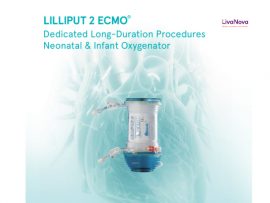Abstract Background The optimal transfusion threshold for patients undergoing venoarterial extracorporeal membrane oxygenation (VA-ECMO) remains uncertain. Methods We used data from OBLEX (ClinicalTrials.gov: NCT03714048), an international, prospective, observational study conducted..
Lee masAbstract Objectives To describe the associations between perioperative blood pressures and clinical postoperative outcomes, and to investigate if these associations depend on the preoperative resting and nadir nighttime blood pressures...
Lee masAbstract Purpose To assess whether prone positioning (PP) increases bleeding risk compared to supine positioning in ARDS patients undergoing veno venous Extracorporeal Membrane Oxygenation (VV ECMO). Materials and Methods A..
Lee masAbstract Background Intraoperative blood salvage can reduce the need for allogeneic blood transfusions, minimizing immunological risks and infection by reusing the patient's own blood. However, in cancer surgery, a key..
Lee masAbstract Implantations of (VADs) have significantly improved and life expectancy of end-stage heart failure patients. However, despite the advancements in the VAD designs and patient management protocols, the VAD recipients remain at..
Lee masAbstract BACKGROUND: Large language models (LLMs) are increasingly used in the medical field and have the potential to reduce workload and improve treatment procedures in clinical practice. This study evaluates..
Lee masAbstract Background - Postoperative hemorrhage is a significant complication of cardiovascular surgery. Although autologous cell salvage is safe and effective for preserving patients' blood, its use in the postoperative context remains..
Lee masIn modern surgical practice,managing perioperative blood loss typically exceeding 500ml to 1liter. is a critical factor impacting patient outcomes ,morbidity and resource mobilization. TYPES OF TRANSFUSION Allogeneic(Homologous) blood transfusion involves..
Lee masAbstract Introduction Blood Stream Infections (BSI) occur in 3-35% of patients on ECMO (Extracorporeal membrane Oxygenation). With the increased use of ECMO since the COVID-19 pandemic, the magnitude of this..
Lee masBlood transfusion and acute kidney injury after cardiac surgery: a retrospective observational study
Abstract Purpose Cardiac surgery-associated acute kidney injury (AKI) is linked to poor outcomes. An observational study from Copenhagen, Denmark identified perioperative red blood cell (RBC) transfusion as a modifiable risk..
Lee masAbstract Background: Extracorporeal membrane oxygenation (ECMO) requires systemic anticoagulation to prevent clotting, typically using unfractionated heparin (UFH). However, anticoagulation carries a bleeding risk, necessitating monitoring. Activated clotting time (ACT) is..
Lee masAbstract To the Editor: Red blood cell (RBC) transfusion is commonly performed during on-pump cardiac surgery; however, excessive use may lead to adverse clinical outcomes and medical resources wastage.[] The call..
Lee masAbstract Objectives The platelet trigger at which to transfuse platelets to prevent bleeding complications in patients supported with extracorporeal membrane oxygenation (ECMO) is unclear. We aimed to elucidate the association..
Lee masAbstract The challenging management of coagulation in cardiothoracic surgery requires a multifaceted approach. The use of pharmacological interventions such as tranexamic acid, heparin, and aprotinin minimizes bleeding but increases the..
Lee masAbstract Blood compatibility, defined as a material’s ability to maintain blood flow without inducing coagulation or hemolysis, was investigated through surface roughness optimization in blood pump flow channels. This study..
Lee masAbstract Intraoperative cell salvage (ICS) is a blood conservation technique utilized in major surgery, yet its application in oncologic procedures remains debated. Concerns persist about the theoretical risk of metastasis..
Lee masAbstract Background: To investigate the factors that influence blood transfusions after neonatal cardiac surgery and their association with prolonged mechanical ventilation (PMV) to provide a basis for optimizing blood transfusion..
Lee masAbstract Introduction Cardiac surgery remains a high-risk procedure for bleeding despite advances in patient blood management. Conventional centrifugation-based autotransfusion devices primarily recover red blood cells, losing platelets and coagulation factors. The..
Lee masAbstract Objective: To identify risk factors for bleeding and thrombotic complications during extracorporeal membrane oxygenation (ECMO) support in adults and to develop a predictive model based on these factors...
Lee masAbstract Background Thrombocytopenia is a recognized risk factor for bleeding during extracorporeal membrane oxygenation (ECMO). This study determines the incidence, risk factors, and clinical relevance of thrombocytopenia and platelet transfusions..
Lee masAbstract Background Autologous blood donation (ABD) can be indicated in pregnant individuals with rare blood groups. Yet, unlike hospitals, some blood establishments are reluctant to collect ABDs in this population...
Lee masAbstract The Working Group on Cardiopulmonary Bypass and Extracorporeal Life Support of China National Center for Cardiovascular Quality Improvement presents evidence-based guidelines on patient blood management for adult cardiac surgery..
Lee masAbstract Background Veno‑venous extracorporeal membrane oxygenation (VV‑ECMO) is associated with a high transfusion burden. While trials have concluded that red blood cell (RBC) storage does not impact patient morbidity and..
Lee masAbstract For patients undergoing extracorporeal membrane oxygenation (ECMO), clot formation is a critical complication requiring high-risk circuit changes. Blood tests used to assess clotting risk may be drawn only four..
Lee masAbstract Objectives Evaluating blood transfusion practices and their impact on morbidity and mortality across extracorporeal membrane oxygenation (ECMO) configurations. Background As ECMO becomes increasingly utilised in critical care, the ideal..
Lee masAbstract Background: The use of cell salvage reduces homologous blood transfusions during operations and avoids associated complications. Therefore, autotransfusion is an integral part of Patient Blood Management (PBM). The..
Lee masAbstract Background Extracorporeal membrane oxygenation (ECMO) provides mechanical circulatory and respiratory support. However, thrombus formation in the circuit can lead to hemorrhagic complications, requiring improvements in ECMO anti-thrombogenicity. Few studies..
Lee masAbstract Objectives To assess concordance between Hemochron Response (ACTr) and the three-activator device Hemochron Signature Elite (ACTe) in adult cardiac surgery patients. To evaluate the correlation between ACTe and anti-Xa..
Lee masAbstract Rotary Blood Pump (RBP) is a commonly used ventricular assist device. However, the constant speed operation of the blood pump leads to a reduction of blood flow pulsatility, which..
Lee masAbstract Bleeding complications are frequently observed in patients undergoing extracorporeal membrane oxygenation and are associated with increased mortality. Due to the complex mechanisms, managing bleeding during ECMO remains a challenge...
Lee mas














